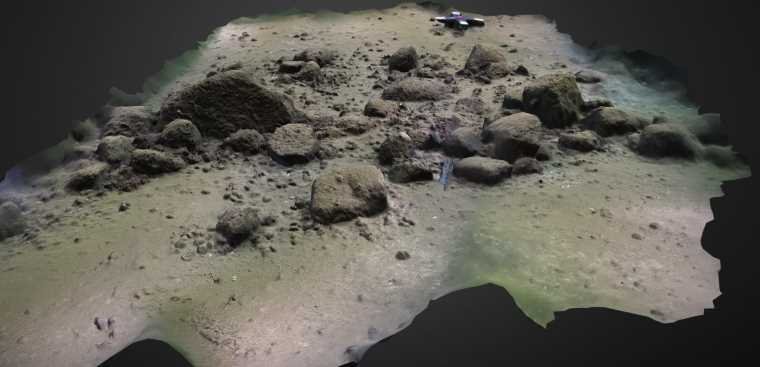Researchers from the Leibniz Institute for Baltic Sea Research in Warnemünde report the discovery of an ancient, 10,000-year-old massive stone wall that has remained submerged beneath the Baltic Sea for millennia.
At nearly a kilometer in length, the Stone Age megastructure hidden beneath the waters of the Bay of Mecklenburg in Germany is not only one of the oldest man-made hunting structures in Europe but likely one of the oldest pieces of construction in the entire world.
“It was likely constructed by hunter–gatherer groups more than 10000 y ago and ultimately drowned during the Littorina transgression at 8500 y B.P.,” the researchers explain in the Proceedings of the National Academy of Sciences. “Since then, it remained hidden at the seafloor, leading to a pristine preservation that will inspire research on the lifestyle and territorial development in the larger area.”
Cross Disciplines of Archaeology and Marine Geoscience Reveal Details of Ancient Massive Stone Wall
When describing the discovery and early excavation of the submerged site, the researchers behind the historic find say that studying sites that have been underwater for this length of time is both rewarding and challenging. For instance, remaining underwater for thousands of years likely helped preserve much of the ancient site. However, studying something that is over 21 meters below the surface also has challenges that archaeologists don’t always face.
“The Baltic Sea basins, some of which only submerged in the mid-Holocene, preserve Stone Age structures that did not survive on land,” they explain. “Yet, the discovery of these features is challenging and requires cross-disciplinary approaches between archeology and marine geosciences.”


To unlock the secrets of this 10,000-year-old massive stone wall, the team employed a number of techniques from both disciplines to characterize their find. For example, hydroacoustic data gathered by shipboard equipment and ancient megastructure. These findings were combined with sedimentological samples and optical imagery collected at the site, revealing numerous details about the wall’s construction.
“The structure is made of 1,673 individual stones, which are usually less than 1 m in height, placed side by side over a distance of 971 m,” the researchers explain, marking the submerged wall as one of the largest man-made hunting structures ever found. The study authors also determined that the wall was likely built along the shoreline of a ‘paleolake’ or bog and was likely used in the hunting of Eurasian reindeer.
Wall’s Builders Were Likely Ancient Hunter-Gatherers
As far as who actually built the massive stone wall, the team says that the location and construction methods unearthed during their aquatic studies indicate it was likely built by hunter-gatherer groups who “roamed the region” after the retreat of the Weichselian Ice Sheet over 10,000 years ago.
Furthermore, the team says their study revealed it was clearly not a natural formation but a constructed one, making it one of the oldest megastructures ever found in the area as well as the world.
“Comparable Stone Age megastructures have become known worldwide in recent times but are almost unknown in Europe,” the research team explains. “The site represents one of the oldest documented man-made hunting structures on Earth and ranges among the largest known Stone Age structures in Europe.”
In their final analysis, the researchers note that the structure clearly stands out for its age and complexity. However, they also point out that this ancient massive stone wall’s well-preserved nature makes it a perfect site to help understand many aspects of the everyday lives of the people who built it.
“It will become important for understanding subsistence strategies and mobility patterns and inspire discussions concerning the territorial development in the Western Baltic Sea region,” they explain.
Christopher Plain is a Science Fiction and Fantasy novelist and Head Science Writer at The Debrief. Follow and connect with him on X, learn about his books at plainfiction.com, or email him directly at christopher@thedebrief.org.

